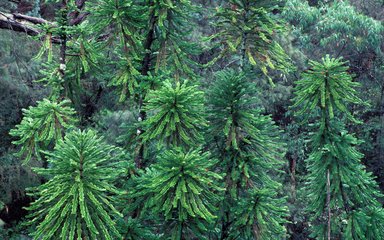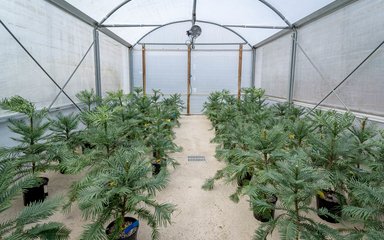The Wollemi pine has been dubbed the ‘dinosaur tree’ because fossil records show this incredible tree was living 200 million years ago alongside the dinosaurs. Thought to have become extinct between 70 and 90 million years ago, a chance discovery in 1994 revealed a small group of living trees in Australia and since then there has been an international effort to make sure the remaining species is not lost. Discover how Bedgebury National Pinetum and Forest in Kent is playing a vital role in this story, joining with international partners to give Wollemi pines a hopeful future.
Rediscovery of the Wollemi pine
In 1994, Australian explorer and botanist David Noble discovered a small group of Wollemi pines growing in a remote gorge in the Wollemi National Park in New South Wales, Australia. This moment is considered one of the greatest botanical discoveries of our time. The tree species is now classified as critically endangered on the Internal Union for Conservation of Nature's (IUCN) red list, an important indicator of the world’s biodiversity which sets out the risks of extinction for plant and animal species.
With fewer than 100 Wollemi pines left growing in a gorge 150 kilometres from Sydney, these wild trees are increasingly vulnerable to threats from diseases and wildfires. They narrowly escaped being destroyed by wildfires in 2019-2020, which burnt more than 10 million hectares of land in eastern Australia.
Watch our video below to learn more about the Wollemi pines project at Bedgebury Pinetum.
Wollemi pines project
Recent advances in genetic techniques have given Australian plant science and conservation experts the opportunity to identify and breed genetically diverse Wollemi pines. For the first time, these collections of young trees are being made available to botanic gardens across the world.
Locations have been chosen with a suitable climate, best suited for the trees to survive climate changes ahead. Together they will create a metacollection - a botanical collection shared by separate organisations but cared for collaboratively to research and conserve the species for the future.
Growing the trees worldwide in this way preserves the widest range of genetic diversity found in the wild population and aims to safeguard Wollemi pines from becoming extinct.

An international partnership
Working in partnership, teams from Forestry England, Botanic Gardens of Sydney, and Botanic Gardens Conservation International (BGCI) identified botanic gardens across the world where the climate will best suit the Wollemi pines.
As the metacollection becomes established, the teams will continue to monitor the trees as they grow and mature.
"Having genetically diverse Wollemi Pines growing in botanic gardens around the world is a great example of how collaborative international conservation efforts will help provide a vital insurance policy against the extinction of this iconic tree in the wild."
- Denise Ora, Botanic Gardens of Sydney Chief Executive
Bedgebury’s involvement with the Wollemi pines
More than 170 young Wollemi pine trees grown by the Botanic Gardens of Sydney were shipped from Australia and were carefully looked after at Forestry England’s tree nursery at Bedgebury. Six were planted in October 2023 to become part of the living collection at the National Pinetum, while the remaining trees were distributed to 28 botanic gardens across the UK and Europe. Separate collections of trees have been sent direct from Sydney to five Australian botanic gardens and one in Atlanta in the USA.
“Discovering the lost Wollemi pines in the wild was a truly astounding moment for international tree conservation and to be a leading partner nearly thirty years later in launching this important new metacollection on UK soil is an exciting moment for Forestry England."
- Mike Seddon, Forestry England Chief Executive


Wollemi pines October 2023 launch event
Botanist and broadcaster, James Wong, joined Forestry England at Bedgebury on 31 October 2023 to help plant six critically endangered Wollemi pine trees.
“Since I first heard the story about the incredible rediscovery of the Wollemi pines, these trees have captured my imagination… I’m excited that through this project these majestic conifers, one of the most botanically fascinating trees on earth, are set to continue not just surviving but thriving into the future.”
- James Wong, botanist and broadcaster
We are excited to have played a leading role in the first stage of an international conservation effort to establish a flourishing, genetically diverse population of these rare trees across the world.
A living gene bank
To help protect the biodiversity of wild trees, Forestry England Bedgebury National Pinetum grows more than 2,000 tree and shrub seedlings every year. Some are planted into the living collection, and others distributed to other botanic gardens and safe sites across the UK and Europe.
As well as offering visitors beautiful trees to walk amongst and enjoy, many of Bedgebury’s species are a ‘living gene bank’ of trees. They provide vital seeds, genetic material and research opportunities and help provide resilient future forest trees, well adapted to changing climate conditions and pests and diseases.



